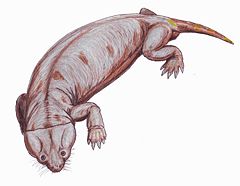| Cistecephalus Assemblage Zone | |
|---|---|
| Stratigraphic range: Late Permian ~ | |
 Cistecephalus microrhinus | |
| Type | Biozone |
| Unit of | Beaufort Group within Adelaide Supgroup |
| Sub-units | Middle Teekloof Formation west of 24°E Uppermost Middleton Formation & lowermost Balfour Formation east of 24°E |
| Underlies | Daptocephalus Assemblage Zone |
| Overlies | Tropidostoma Assemblage Zone |
| Thickness | up to 984.252 ft (300.000 m) |
| Location | |
| Region | Eastern, Northern & Western Cape |
| Country | |
| Extent | Karoo Basin |
| Type section | |
| Named for | Cistecephalus |
| Named by | Robert Broom |
| Year defined | 1906, 1909 |
The Cistecephalus Assemblage Zone is a tetrapod assemblage zone or biozone found in the Adelaide Subgroup of the Beaufort Group, a majorly fossiliferous and geologically important geological group of the Karoo Supergroup in South Africa.[1][2][3] This biozone has outcrops located in the Teekloof Formation north-west of Beaufort West in the Western Cape, in the upper Middleton and lower Balfour Formations respectively from Colesberg of the Northern Cape to east of Graaff-Reinet in the Eastern Cape. The Cistecephalus Assemblage Zone is one of eight biozones found in the Beaufort Group, and is considered to be Late Permian in age.[4]
The name of the biozone refers to Cistecephalus, a small, burrowing dicynodont therapsid. It is characterized by the presence of this species, known especially from the upper sections of this biozone, and the first appearance of the dicynodont Aulacephalodon.
- ^ J., Hancox, P.; S., Rubidge, B. (1997). "The role of fossils in interpreting the development of the Karoo Basin". Palaeontologia Africana. ISSN 0078-8554. Archived from the original on 2018-05-28. Retrieved 2018-05-28.
{{cite journal}}: CS1 maint: multiple names: authors list (link) - ^ Rubidge, B. S. (1995). Biostratigraphy of the Beaufort Group(Karoo Supergroup). Biostratigraphic series.
- ^ Merrill, van der Walt; Michael, Day; Bruce, Rubidge; K., Cooper, Antony; Inge, Netterberg (December 2010). "A new GIS-based biozone map of the Beaufort Group (Karoo Supergroup), South Africa". Palaeontologia Africana. ISSN 0078-8554.
{{cite journal}}: CS1 maint: multiple names: authors list (link) - ^ Kammerer, C. (2008, September). A new therocephalian from the Cistecephalus Assemblage Zone of South Africa and new information on therocephalian systematics. In Journal of Vertebrate Paleontology (Vol. 28, No. 3, pp. 98A-99A). 60 REVERE DR, STE 500, NORTHBROOK, IL 60062 USA: SOC VERTEBRATE PALEONTOLOGY.